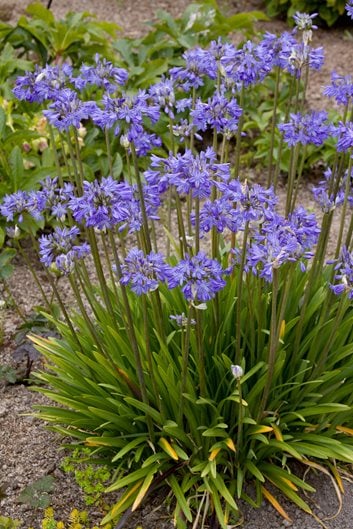Grasping the Art of Agapanthus Care: Essential Steps for Healthy And Balanced Development and Vivid Flowers
In the world of horticulture, the cultivation of agapanthus stands as a satisfying venture for those that look for to support these classy blooming plants. With their striking blossoms and elegant vegetation, agapanthus has actually recorded the focus of gardeners worldwide. However, accomplishing ideal development and vivid blooms needs a nuanced technique that encompasses different essential steps. From choosing the best range to grasping trimming methods, the journey in the direction of growing thriving agapanthus plants is complex and holds the vital to opening the complete capacity of these botanical gems.
:strip_icc()/agapanthus-africanus-b959396b-5696f86e059c46f299d1834ba687c6eb.jpg)
Picking the Right Agapanthus Selection

When picking the right Agapanthus variety for your garden, think about aspects such as environment viability, flower color, and growth practice. Agapanthus, frequently known as Lily of the Nile or African lily, is available in a range of colors varying from shades of blue and purple to white. Pick a bloom color that complements your existing garden scheme to produce an unified landscape. Additionally, consider the climate in your region to make sure the Agapanthus range you choose can grow in your certain problems. Some varieties are much more forgiving of cool temperature levels, while others favor warmer environments. Recognizing the growth practice of different Agapanthus selections is critical for appropriate placement within your yard. Some selections have a clumping development practice, ideal for containers or borders, while others have a more spreading nature, suitable for ground cover or mass growings. By very carefully evaluating these variables, you can select the ideal Agapanthus selection to improve the charm of your yard.
Perfect Planting Problems
Considering the ideal ecological demands is vital for effective Agapanthus cultivation. Agapanthus prospers in well-draining dirt with a somewhat acidic to neutral pH degree. When planting, select an area that receives complete sunshine to partial shade. In hotter climates, supplying some mid-day shade can stop scorching of the fallen leaves. Agapanthus plants are sensitive to chilly temperature levels and should be secured from frost throughout winter season.
To ensure healthy and balanced development and lively flowers, plant Agapanthus bulbs at a deepness of concerning 2-4 inches and area them 8-12 inches apart. Mulching around the base of the plants assists retain moisture and subdues weed growth.
Watering and Fertilizing Tips
Maintaining correct wetness levels and giving necessary nutrients are crucial elements in the treatment routine for Agapanthus plants. When it pertains to watering Agapanthus, it is critical to strike an equilibrium. These plants choose consistently damp soil yet are vulnerable to root rot if overwatered. Throughout the expanding season, water deeply once a week, making certain the dirt is well-draining to prevent waterlogging. In hotter climates or throughout periods of dry spell, more regular watering may be required to keep the soil uniformly moist. Nonetheless, decrease watering in the wintertime to stop more information waterlogged problems.
Fertilizing Agapanthus is essential for advertising healthy and balanced development and respected blossoms. Use a balanced fertilizer, such as a 10-10-10 formula, in the early spring as new growth emerges. By following these watering and fertilizing tips, you can ensure your Agapanthus plants thrive and produce vibrant, long-lasting blooms.
Trimming Strategies for Agapanthus
Trimming Agapanthus plants at the proper times and with proper strategies is critical for keeping their health and wellness and promoting optimum development and blooming. The ideal time to trim Agapanthus is in late winter or very early spring prior to brand-new development arises.
For flowered stems, wait till the blossoms have actually withered and after that trim them back to the base. This not only cleans the plant's appearance yet additionally encourages the growth of new blossom buds. Deadheading spent blossoms can likewise reroute the plant's energy right into creating even more blooms instead of setting seeds. Nonetheless, if you want to accumulate seeds for proliferation, leave some flowers to mature and dry Read More Here on the plant.
Keep in mind to make use of clean, sharp devices to make precise cuts and decrease the threat of introducing illness. Agapanthus. Normal pruning will certainly help keep your Agapanthus looking cool and healthy while guaranteeing a plentiful display of gorgeous blossoms
Handling Common Bugs and Conditions
After making certain correct trimming strategies for Agapanthus, it is crucial to address usual parasites and conditions that can influence the wellness and vitality of these plants. One common insect that affects Agapanthus is the Agapanthus gall midge.
Additionally, Agapanthus plants can endure from root rot if they are grown in poorly draining pipes soil. By being watchful and taking punctual read the article action versus illness and pests, you can assist your Agapanthus plants thrive and create vibrant blossoms. Agapanthus.

Verdict
In conclusion, mastering the art of agapanthus care involves selecting the best variety, supplying optimal planting problems, appropriate watering and feeding, proper trimming methods, and resolving common insects and conditions. By adhering to these essential actions, you can make sure healthy and balanced growth and vivid flowers for your agapanthus plants. Keep in mind to regularly keep track of and preserve your plants to promote their total wellness and durability.
To guarantee healthy and balanced development and vibrant flowers, plant Agapanthus light bulbs at a depth of regarding 2-4 inches and room them 8-12 inches apart. By complying with these watering and fertilizing pointers, you can ensure your Agapanthus plants grow and create lively, long-lasting flowers.
One common parasite that affects Agapanthus is the Agapanthus gall midget. In addition, Agapanthus plants can experience from root rot if they are grown in improperly draining dirt. By complying with these important steps, you can make sure healthy development and lively blooms for your agapanthus plants.